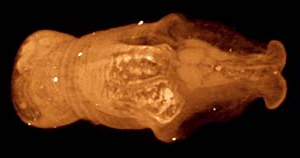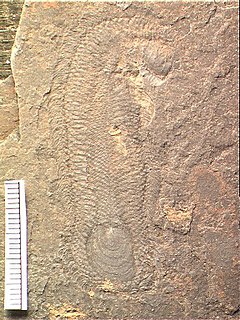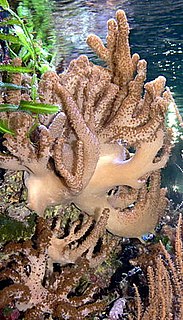Genus is a taxonomic rank used in the biological classification of living and fossil organisms as well as viruses. In the hierarchy of biological classification, genus comes above species and below family. In binomial nomenclature, the genus name forms the first part of the binomial species name for each species within the genus.

Wiwaxia is a genus of soft-bodied animals that were covered in carbonaceous scales and spines that protected it from predators. Wiwaxia fossils – mainly isolated scales, but sometimes complete, articulated fossils – are known from early Cambrian and middle Cambrian fossil deposits across the globe. The living animal would have measured up to 5 cm (2 inch) when fully grown, although a range of juvenile specimens are known, the smallest being 2 millimetres (0.079 in) long.

Aplacophora is a presumably paraphyletic taxon. This is a class of small, deep-water, exclusively benthic, marine molluscs found in all oceans of the world.

The halkieriids are a group of fossil organisms from the Lower to Middle Cambrian. Their eponymous genus is Halkieria, which has been found on almost every continent in Lower to Mid Cambrian deposits, forming a large component of the small shelly fossil assemblages. The best known species is Halkieria evangelista, from the North Greenland Sirius Passet Lagerstätte, in which complete specimens were collected on an expedition in 1989. The fossils were described by Simon Conway Morris and John Peel in a short paper in 1990 in the journal Nature. Later a more thorough description was undertaken in 1995 in the journal Philosophical Transactions of the Royal Society of London and wider evolutionary implications were posed.

Alcyonacea, or soft corals, are an order of corals. In addition to the fleshy soft corals, the order Alcyonacea now contains all species previously known as "gorgonian corals", that produce a more or less hard skeleton, though quite different from "true" corals (Scleractinia). These can be found in suborders Holaxonia, Scleraxonia, and Stolonifera. They are sessile colonial cnidarians that are found throughout the oceans of the world, especially in the deep sea, polar waters, tropics and subtropics. Common names for subsets of this order are sea fans and sea whips; others are similar to the sea pens of related order Pennatulacea. Individual tiny polyps form colonies that are normally erect, flattened, branching, and reminiscent of a fan. Others may be whiplike, bushy, or even encrusting. A colony can be several feet high and across, but only a few inches thick. They may be brightly coloured, often purple, red, or yellow. Photosynthetic gorgonians can be successfully kept in captive aquaria.

Neritidae, common name the nerites, is a taxonomic family of small to medium-sized saltwater and freshwater snails which have a gill and a distinctive operculum.

Chrysomallon squamiferum, commonly known as the scaly-foot gastropod, scaly-foot snail, or sea pangolin, is a species of deep-sea hydrothermal-vent snail, a marine gastropod mollusc in the family Peltospiridae. This vent-endemic gastropod is known only from deep-sea hydrothermal vents in the Indian Ocean, where it has been found at depths of about 2,400–2,900 m (1.5–1.8 mi). C. squamiferum differs greatly from other deep-sea gastropods, even the closely related neomphalines. In 2019, it was declared endangered on the IUCN Red List, the first species to be listed as such due to risks from deep-sea mining of its vent habitat that also produce high-quality metal ores.
Theelia is an extinct genus of sea cucumbers that existed from 312 to 40.4 million years ago.

Epimenia is a genus of cavibelonian solenogasters, a kind of shell-less, worm-like mollusks.

Mazocraeidea is an order in the subclass Polyopisthocotylea within class Monogenea.

Melithaeidae is a family of corals in the suborder Scleraxonia. Members of the family are commonly known as sea fans and are found on reefs in the tropical regions of the Indo-Pacific.

Gersemia is a genus of soft corals in the family Nephtheidae. Species in this genus are found in cold temperate and polar seas at depths ranging from 20 metres (66 ft) to over 2,000 metres (6,600 ft). The type species is Gersemia loricata.

Gersemia rubiformis, commonly known as the sea strawberry, is a species of soft coral in the family Nephtheidae. It is found in the northwest Atlantic and the northeast Pacific Oceans.

Plexauridae is a family of marine colonial octocorals in the phylum Cnidaria. Members of this family are found in shallow tropical and subtropical seas. Many species contain symbiotic photosynthetic protists called zooxanthellae.

Plexaurella nutans, the giant slit-pore sea rod, is a tall species of soft coral in the family Plexauridae. It is a relatively uncommon species and is found in shallow seas in the Caribbean region.

Echinoptilidae is a family of sea pens, a member of the subclass Octocorallia in the phylum Cnidaria.

Protomicrocotylidae is a family of monogenean parasites in the order Mazocraeidea.

Eunicea is a genus of gorgonian-type octocorals in the family Plexauridae. These branched octocorals typically have knobby protuberances from which the polyps protrude. They are often stiffened by purple sclerites and some colonies, in brightly lit back-reef areas are purple, though most colonies are brown or grey. The polyps in some species are large and feathery in appearance. The growth of these corals is rapid and they can be kept in a reef aquarium.
Taiaroa is a genus of deep-water, solitary marine octocorals in the family Taiaroidae. Taiaroa is monotypic in the family Taiaroidae and contains a single species, Taiaroa tauhou. The species was first described by the marine zoologists Frederick M. Bayer and Katherine Margaret Muzik in 1976. The scientific name derives from "Taiaroa", the submarine canyon off New Zealand in which the first specimens were found and "tauhou", the Maori word for "strange".
Pauleo jubatus is a species of sea slug, specifically an aeolid nudibranch. It is a marine gastropod mollusc in the family Facelinidae. It is the only species in the genus Pauleo.

















